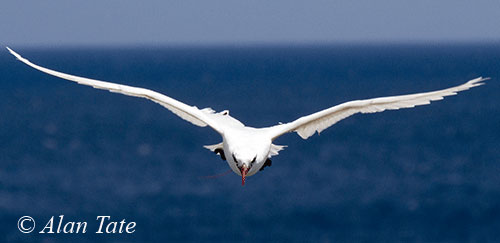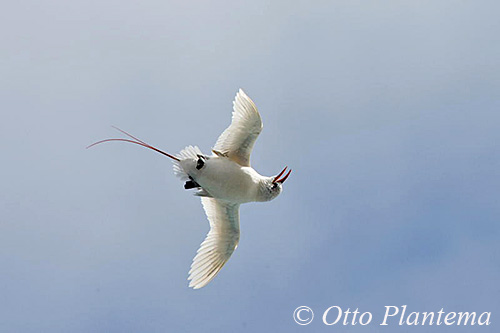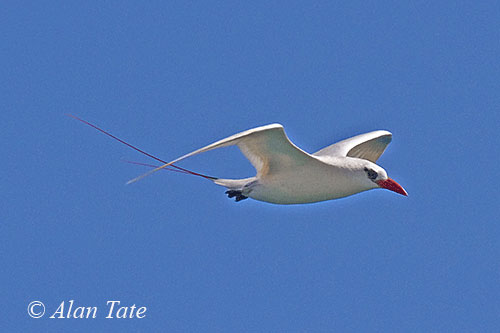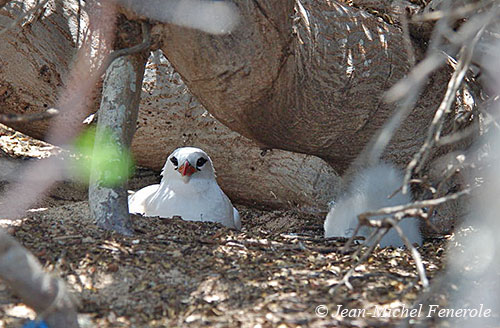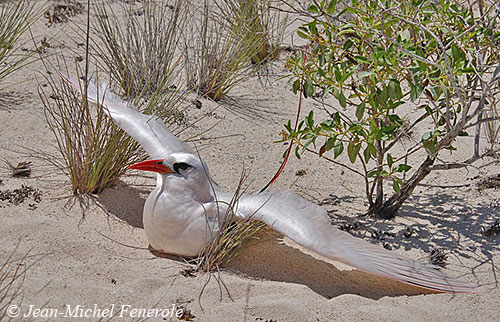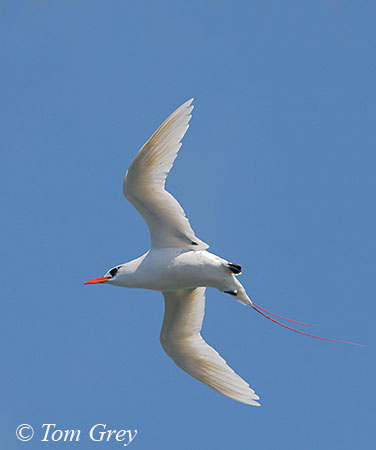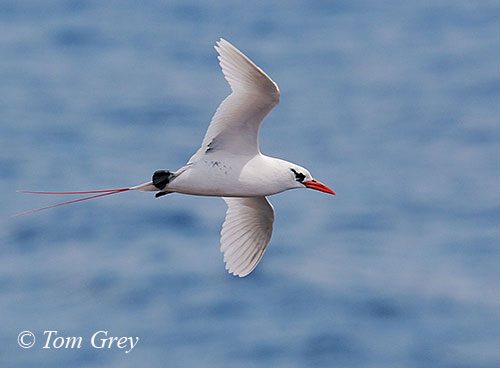
Red-tailed Tropicbird
Phaethon rubricauda
Phaethontiformes Order – Phaethontidae Family
BIOMETRICS:
Length: 78-81 cm
Wingspan: 105-120 cm
Weight: 600-830 g
LONGEVITY : up to 16 years
DESCRIPTION:
Red-tailed tropicbird is the less common of tropicbirds, and the largest of the three species.
Adult has white plumage overall, tinged pink in fresh plumage.
On the upperwings, we can see fine black edges on the outer primaries, and broader black edges on tertials.
Tail is white and fan-shaped, with long, red central streamers of about 30 to 35 cm length.
The underparts are white.
Head is white too, with black eye-line, from lores to ear-coverts.
Pointed bill is red. Eyes are dark brown. Legs and webbed feet are black.
Both sexes are similar.
Juvenile has heavily barred upperparts. It lacks the red tail streamers. Bill is blackish. It reaches its sexual maturity at four years.
We can find four subspecies that differ in size of bill and wings, and intensity of pink tinge.
P.r. rubricauda (described above)breeds on islands in W Indian Ocean.
P.r. westralis is found in islands in E Indian Ocean and Easter Island.
P.r. roseotinctus breeds in SW Pacific islands.
P.r. melanorhynchus breeds and disperses widely in W, C and S tropical Pacific Ocean.
FLIGHT:
Red-tailed Tropicbird has agile flight, performing spectacular flight displays and aerobatics. It is the heaviest of the Tropicbirds, with shorter wings, and its flight is less graceful than in the two other species.
Outside flight displays, Red-tailed Tropicbird performs strong, direct flight with powerful wing beats, sometimes interspersed with soaring and glides.
REPRODUCTION:
Breeding season occur year round, with a peak between March and August.
Red-tailed Tropicbirds form loose colonies on small islands. It nests in cliffs, in rocky crevices or on the ground in sheltered scrape.
Female lays only one egg, from brown to purplish-black colours. Incubation lasts about 42 to 46 days, shared by both adults.
Chick is covered with pale grey to white down at hatching. It is brooded during the first week. Both parents feed it with regurgitated food directly into the chick’s throat.
The young fledge about 12 to 13 weeks after hatching. At this moment, it has grey and white plumage, and dark grey bill.
DIET:
Red-tailed Tropicbird feeds on fish, mainly on flying fish taken in flight. It also consumes squid and crustaceans.
PROTECTION / THREATS / STATUS:
Red-tailed Tropicbird populations are relatively stable at this moment.
They are vulnerable to introduced predators such as cats and rats.
In its Pacific range, the red tail streamers are used as ornaments.
Fr: Phaéton à brins rouges
All : Rotschwanz-Tropikvogel
Esp : Rabijunco Colirrojo
Ital : Fetone codarossa
Nd : Roodstaartkeerkringvogel
Russe : Краснохвостый фаэтон
Sd : Rödstjärtad tropikfågel
Photographers:
Jean Michel Fenerole
Photos d’Oiseaux du monde
Tom Grey
Tom Grey's Bird Pictures
Otto Plantema
Trips around the world
Alan & Ann Tate
AA Bird Photography
Text by Nicole Bouglouan
Sources :
HANDBOOK OF THE BIRDS OF THE WORLD vol 1 by Josep del Hoyo-Andrew Elliot-Jordi Sargatal - Lynx Edicions - ISBN: 8487334105
CREAGUS@Monterey Bay (Don Roberson)
Wikipedia, the free encyclopaedia
Bird Friends of San Diego County (Audubon Society)
VOICE: SOUNDS BY XENO-CANTO
Red-tailed Tropicbird utters tern-like shrieks during flight displays. We can also hear guttural squawks and high whistles.
HABITAT:
Red-tailed Tropicbird is pelagic. It breeds on small oceanic islands in cliffs.
RANGE:
Red-tailed Tropicbird breeds across Indian and Pacific Oceans.
BEHAVIOUR:
Red-tailed Tropicbird feeds mainly on fish, and particularly on flying fish, squid and crustaceans. It catches its preys by plunge-diving from about 6 to 50 metres height, and often takes flying fish in flight.
Red-tailed Tropicbird feeds offshore, often alone, rarely in flocks. It spends most of its time flying over water, searching for food.

